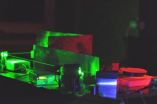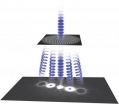(Press-News.org) JILA researchers have developed a laser-based source of terahertz radiation that is unusually efficient and less prone to damage than similar systems. The technology might be useful in applications such as detecting trace gases or imaging weapons in security screening.
JILA is a joint institute of the National Institute of Standards and Technology (NIST) and the University of Colorado at Boulder.
Terahertz radiation—which falls between the radio and optical bands of the electromagnetic spectrum—penetrates materials such as clothing and plastic but can be used to detect many substances that have unique absorption characteristics at these wavelengths. Terahertz systems are challenging to build because they require a blend of electronic and optical methods.
The JILA technology, described in Optics Letters,* is a new twist on a common terahertz source, a semiconductor surface patterned with metal electrodes and excited by ultrafast laser pulses. An electric field is applied across the semiconductor while near-infrared pulses lasting about 70 femtoseconds (quadrillionths of a second), produced 89 million times per second, dislodge electrons from the semiconductor. The electrons accelerate in the electric field and emit waves of terahertz radiation.
The JILA innovations eliminate two known problems with these devices. Adding a layer of silicon oxide insulation between the gallium arsenide semiconductor and the gold electrodes prevents electrons from becoming trapped in semiconductor crystal defects and producing spikes in the electric field. Making the electric field oscillate rapidly by applying a radiofrequency signal ensures that electrons generated by the light cannot react quickly enough to cancel the electric field.
The result is a uniform electric field over a large area, enabling the use of a large laser beam spot size and enhancing system efficiency. Significantly, users can boost terahertz power by raising the optical power without damaging the semiconductor. Sample damage was common with previous systems, even at low power. Among other advantages, the new technique does not require a microscopically patterned sample or high-voltage electronics. The system produces a peak terahertz field (20 volts per centimeter for an input power of 160 milliwatts) comparable to that of other methods.
While there are a number of different ways to generate terahertz radiation, systems using ultrafast lasers and semiconductors are commercially important because they offer an unusual combination of broad frequency range, high frequencies, and high intensity output.
NIST has applied for a provisional patent on the new technology. The system currently uses a large laser based on a titanium-doped sapphire crystal but could be made more compact by use of a different semiconductor and a smaller fiber laser, says senior author Steven Cundiff, a NIST physicist.
INFORMATION:
* H. Zhang J.K. Wahlstrand, S.B. Choi and S.T. Cundiff. Contactless photoconductive terahertz generation. Optics Letters, Jan. 15, 2011.
New wave: JILA develops efficient source of terahertz radiation
2011-01-21
ELSE PRESS RELEASES FROM THIS DATE:
Eggs show arctic mercury cycling may be linked to ice cover
2011-01-21
An international research team working with National Institute of Standards and Technology (NIST) scientists at the Hollings Marine Laboratory (HML) in Charleston, S.C., has suggested for the first time that mercury cycling in the flora and fauna of the Arctic may be linked to the amount of ice cover present. Their study* is the latest work reported from the Seabird Tissue Archival and Monitoring Project (STAMP), a multiyear joint effort of NIST, the U.S. Fish and Wildlife Service (USFWS), the U.S. Geological Survey (USGS) and the Bureau of Indian Affairs to track trends ...
NIST advances single photon management for quantum computers
2011-01-21
The quantum computers of tomorrow might use photons, or particles of light, to move around the data they need to make calculations, but photons are tricky to work with. Two new papers* by researchers working at the National Institute of Standards and Technology (NIST) have brought science closer to creating reliable sources of photons for these long-heralded devices.
In principle, quantum computers can perform calculations that are impossible or impractical using conventional computers by taking advantage of the peculiar rules of quantum mechanics. To do this, they need ...
Real-world graphene devices may have a bumpy ride
2011-01-21
Electronics researchers love graphene. A two-dimensional sheet of carbon one atom thick, graphene is like a superhighway for electrons, which rocket through the material with 100 times the mobility they have in silicon. But creating graphene-based devices will be challenging, say researchers at the National Institute of Standards and Technology (NIST), because new measurements show that layering graphene on a substrate transforms its bustling speedway into steep hills and valleys that make it harder for electrons to get around.
In a new article in Nature Physics,* NIST ...
Stretching the truth: JILA biophysicists help unravel DNA stretching mystery
2011-01-21
Using a new experimental test structure, biophysicists at JILA have unraveled part of a 15-year mystery in the mechanics of DNA—just how the molecule manages to suddenly extend to almost twice its normal length. The new test structure should support research on DNA elasticity as a standard for tiny forces and help refine studies of how drugs and other substances bind to DNA.
In a new paper in the Journal of the American Chemical Society,* JILA scientists disprove a leading explanation for DNA overstretching, a curious behavior in which the molecule's double helix structure ...
Identifying factors in atrazine's reduced weed control
2011-01-21
MADISON, WI, JANUARY 19, 2011 – Invasive broadleaf weeds can destroy corn crops and fallow fields. Farmers use the chemical atrazine in herbicides to protect their plants. Despite atrazine's controversial environmental impacts, it can provide long term residual control of many weed species. However, the loss of atrazine's effectiveness has been a challenge for farmers in northeastern Colorado.
In a collaborative study between scientists at the USDA-Agricultural Research Service Water Management Research Unit and Colorado State University, soil samples were collected from ...
NIST puts a new twist on the electron beam
2011-01-21
Electron microscopes are among the most widely used scientific and medical tools for studying and understanding a wide range of materials, from biological tissue to miniature magnetic devices, at tiny levels of detail. Now, researchers at the National Institute of Standards and Technology (NIST) have found a novel and potentially widely applicable method to expand the capabilities of conventional transmission electron microscopes (TEMs). Passing electrons through a nanometer-scale grating, the scientists imparted the resulting electron waves with so much orbital momentum ...
Study yields better turbine spacing for large wind farms
2011-01-21
Large wind farms are being built around the world as a cleaner way to generate electricity, but operators are still searching for the most efficient way to arrange the massive turbines that turn moving air into power.
To help steer wind farm owners in the right direction, Charles Meneveau, a Johns Hopkins fluid mechanics and turbulence expert, working with a colleague in Belgium, has devised a new formula through which the optimal spacing for a large array of turbines can be obtained.
"I believe our results are quite robust," said Meneveau, who is the Louis Sardella ...
Are positive emotions good for your health in old age?
2011-01-21
The notion that feeling good may be good for your health is not new, but is it really true? A new article published in Current Directions in Psychological Science, a journal of the Association for Psychological Science, reviews the existing research on how positive emotions can influence health outcomes in later adulthood.
"We all age. It is how we age, however, that determines the quality of our lives," said Anthony Ong of Cornell University, author of the review article. The data he reviews suggest that positive emotions may be a powerful antidote to stress, pain, ...
With chemical modification, stable RNA nanoparticles go 3-D
2011-01-21
CINCINNATI—For years, RNA has seemed an elusive tool in nanotechnology research—easily manipulated into a variety of structures, yet susceptible to quick destruction when confronted with a commonly found enzyme.
"The enzyme RNase cuts RNA randomly into small pieces, very efficiently and within minutes," explains Peixuan Guo, PhD, Dane and Mary Louise Miller Endowed Chair and professor of biomedical engineering at the University of Cincinnati (UC). "Moreover, RNase is present everywhere, making the preparation of RNA in a lab extremely difficult."
But by replacing a ...
Louisiana Tech University professor visits India as part of US delegation on energy issues
2011-01-21
RUSTON, La. – While most people were busy shopping during the holiday season, Dr. Daniela Mainardi, associate professor of chemical engineering at Louisiana Tech University and member of the Institute for Micromanufacturing, was preparing for a trip that would take her half way around the world.
As part of a joint effort, Mainardi, together with Virendra Mathur from the University of New Hampshire, and Suddhasatwa Basu and Shantanu Roy from The Indian Institute of Technology-Delhi, was in charge of organizing a workshop titled, "Energy and Environment: Challenges and ...




